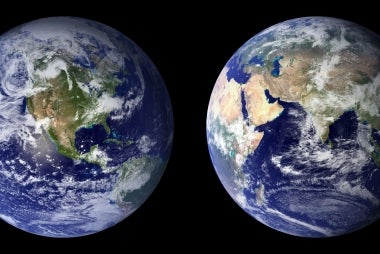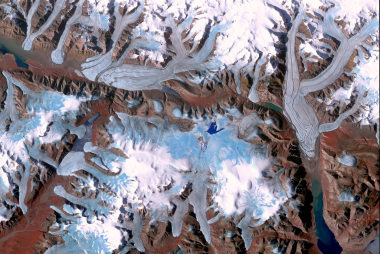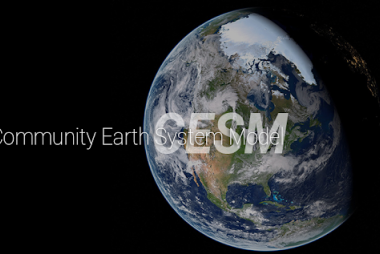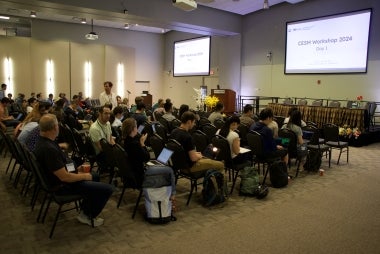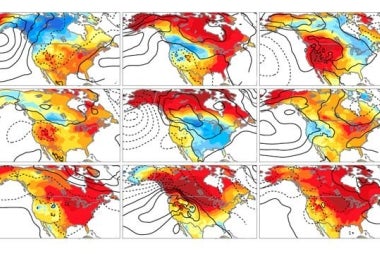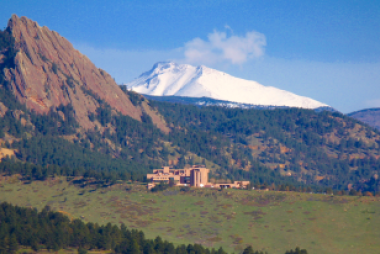April 2025 Newsletter Issue
Welcome to the Community Earth System Model (CESM) Newsletter. Want to receive our next newsletter in your inbox? Visit our newsletter page to subscribe and never miss a newsletter.
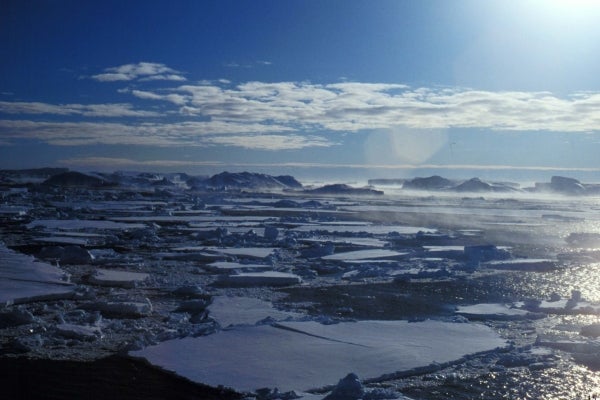
Credit
Photo by Elizabeth Hunke
|
In this Newsletter:
Chief Scientist Message
30th Annual CESM Workshop
Plenary Speakers for the 30th Annual CESM Workshop
Faculty Network
Searching for Photos from past CESM Workshops
CESM Winter Working Group Video Recordings Available
Research Highlights from Our Community
Quick Links
Chief Scientist Message
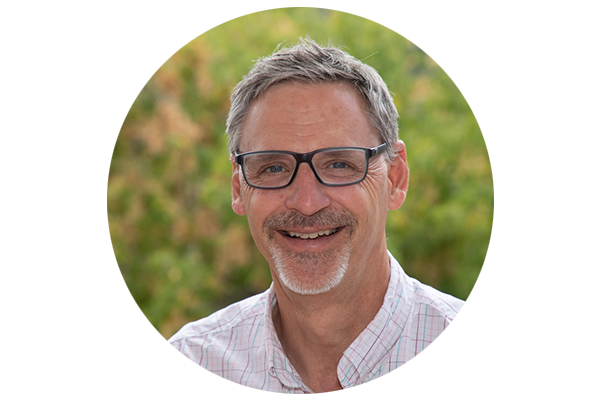
|
I want to begin by acknowledging the ongoing anxiety and sadness that so many of us are feeling as we hear and read about layoffs, restrictions, and reduced science budgets at NSF and other federal agencies. With all of this uncertainty, it can be challenging to maintain focus on research. But, I have been impressed and thankful for the continued dedication and effort of the CESM development team and for the broader CESM research community that continues to utilize CESM and CESM model output to conduct impactful research.
Within the broader context of this uncertainty, we are pushing forward with CESM activities. The 30th Annual CESM Workshop is coming up on June 9-11. To commemorate the 30th Workshop, we have several special events lined up, including a panel session with all the prior CESM Chief Scientists, where we will be discussing the future of Earth System modeling and science. More details about the workshop, along with links for registration and presentation requests, are below. As always, we are looking forward to the opportunity to engage with the CESM community, to meet new students and postdocs, and to foster new collaborations and directions for CESM. Note that limited travel and registration support is available to early career participants who wish to give a presentation. The deadline for presentation requests is April 30, and the deadline for in-person registration is May 29!
The CESM Workshop arrives during a period when the CESM development team is working hard to produce a final CESM3 version. We are steadfastly working through a series of issues and biases with the beta version, and are testing the updated forcing datasets from CMIP, as well as improving our workflows to ease the use of CESM for everyone. The CESM Workshop will be an opportunity for us to share the status and progress towards CESM3.
Also included below is some information about our new effort to form a Faculty Network for Teaching with CESM. We’ve spent time over the past year collecting information from faculty about how we can better support them and help them support each other in the use of CESM in their curricula. We are excited to see how this effort progresses. The CESM Tutorial is also coming up in early July, and many NSF NCAR staff are working to update and improve tutorial materials, which will hopefully also be useful for faculty.
Thanks for reading, and I hope to see many of you at the 30th Annual CESM Workshop.
30th Annual CESM Workshop
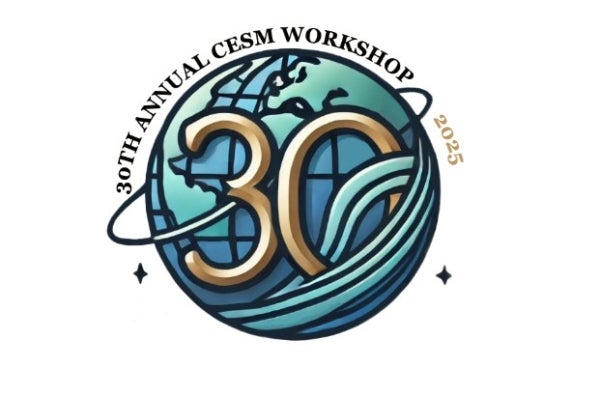
|
The CESM Workshop will begin on Monday, 9 June 2025. The day will include presentations on the state of the CESM, presentations by this year's award recipients, and plenary presentations followed by CESM Working Group Meetings in the afternoon and an interactive poster session.
On 10-11 June 2025, there will be Working Group and Cross-Working Group sessions designed to share information and encourage discussion and collaboration.
Tuesday afternoon will include a CESM 30th Annual Workshop Celebration with CESM history talks and a round-table discussion about the future of Earth System modeling and science with previous CESM Chief Scientists (Jeff Kiehl, Bill Collins, Jim Hurrell, Peter Gent, Marika Holland, Jean-Francois Lamarque, and Gokhan Danabasoglu), followed by a reception, dinner, and music.
The two Cross-Working Group sessions this year will be:
I. Harnessing Machine Learning for CESM: Innovation and Integration that focuses on ML applications in both model development and CESM simulation analysis.
II. High Resolution: This session will focus on the successes, opportunities, and challenges with the development and application of CESM (coupled or component models) at high resolutions, inclusive of 10-25km resolutions down to km-scale resolutions and including regionally-refined or regional modeling capabilities.
In addition to traditional activities of the Polar Climate (PCWG) and Biogeochemistry (BGCWG) working groups, these working groups are also organziing their sessions around work related to biogeochemical and ecological work in polar regions.
🚨 Call for Abstracts 🚨
- Please use this Google Form to submit a request for a presentation at the 2025 CESM Workshop.
- Submit your request by April 30, 2025!
- You will be notified if your talk or poster is accepted the week of May 5, 2025.
- In-person registration closes May 29, 2025.
- Registration to participate online will remain open through the duration of the workshop.
Meeting details and lodging options are available on the website.
30th Annual CESM Workshop Celebration
As noted above, we look forward to celebrating the 30th Annual CESM Workshop on Tuesday, June 10th with talks and a round table with former Chief Scientists, followed by a networking reception with workshop participants. For those wishing to attend just this afternoon/evening celebration event, there will be no registration fee to attend in person. Please fill out this form if you'd like to join for just this celebratory event.
Plenary Speakers for the 30th Annual CESM Workshop
Mind the Gap: Human Systems are a Missing, Critical Component for Earth Systems Modeling
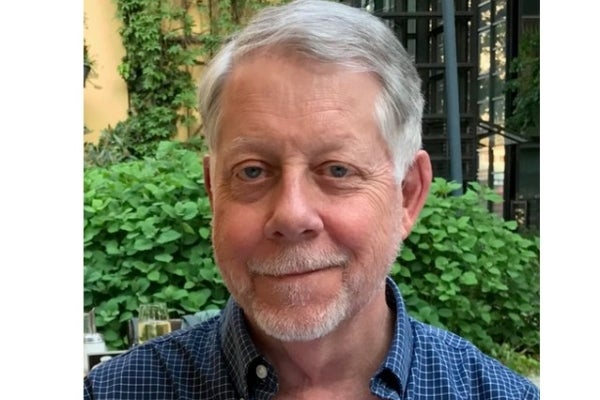
|
Michael Barton is a complex system scientist and Professor in the Schools of Complex Adaptive Systems and Human Evolution & Social Change at Arizona State University (USA). He is Executive Director of the Open Modeling Foundation, a global consortium of organizations to promote standards and best practices in computational modeling across the social and natural sciences. He also directs the Network for Computational Modeling in Social and Ecological Sciences, an international scientific network to enable accessibility, open science, and best practices for computation in the socio-ecological sciences. Barton's research centers around long-term human ecology, landscape dynamics, and the multi-dimensional interactions between social and biophysical systems, integrating computational modeling, geospatial technologies, and data science with geoarchaeological field studies. Barton has directed transdisciplinary research on hunter-gatherers and small-holder farmers in the Mediterranean and North America for over three decades, and directs research on human-environmental interactions in the modern world. Web page and CV at: https://cmbarton.github.io/.
From Earth System Science to Societal Impact: One Scientist's Journey

|
Dr. Hansi Singh is co-founder and CEO of Planette AI, a venture-backed, mission-driven environmental forecasting startup based in San Francisco, CA. She has a PhD in atmospheric sciences and an MS in applied mathematics from the University of Washington, and was a recipient of the US Department of Energy's Computational Sciences Graduate Fellowship and Linus Pauling Distinguished Postdoctoral Fellowship. Before Planette, she held a faculty position at the University of Victoria School and Earth and Ocean Sciences, with research focused on coupled climate dynamics and polar sensitivity.
Bridging the Gap: Communicating Earth System Science to Stakeholders, Communities, and Decision Makers
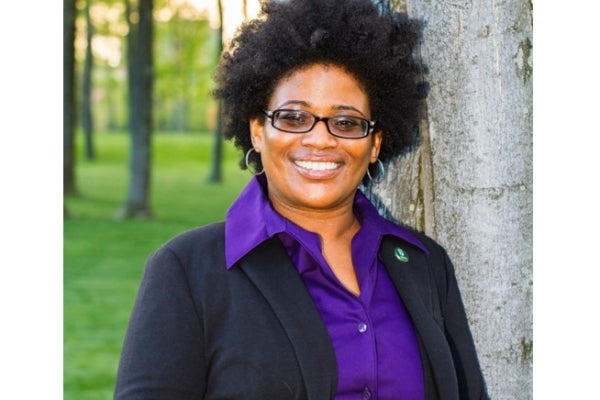
|
Dr. Paula R. Buchanan is a practitioner-academic (“pracademic”), sociohydrologist, and disaster and emergency management researcher. She researches sustainable drinking water access issues, focusing on the intersections between public health, risk and science communication, sociology, and emergency management. As a socio-hydrologist, her research focuses on how people interact with drinking water systems, and human behavior’s impact on these systems that support drinking water to sustain life. A central question of Dr. Buchanan’s research is the extent to which socio-technical systems function as a communication channel to provide populations with accurate information to mitigate impacts associated with, or exacerbated by, water-based disasters. She is interested in using mixed methods to better understand the multi-faceted nature of her interdisciplinary research interests. As a self-proclaimed data nerd, Dr.Buchanan is also passionate about using data science, information technology, and data
Visualizations as tools to more effectively communicate with targeted audiences.
Faculty Network for Teaching with CESM
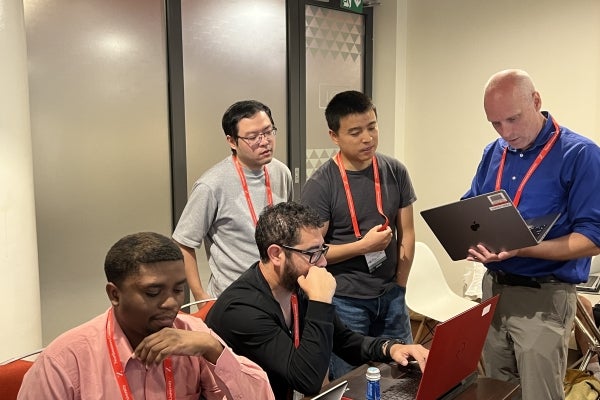
|
Over the past year, we have been collecting information through a survey and through virtual discussion forums about how we can facilitate the sharing of information and resources to help faculty best utilize CESM and its components or simpler models in their undergraduate or graduate curricula. Thanks to all the faculty members who either responded to the survey or participated in our virtual forums. Nearly 70 faculty members filled in the survey, indicating that they are either already using CESM in their classrooms or that they would like to. We learned about many common issues, including concerns about computational resources, challenges with porting CESM, the complexity of CESM, and the lack of time to develop curricula. What is clear is that a big step forward is a centralized location where faculty can go to get all the information that they would need to get started. This includes information about computing allocations and options, tutorial material, configuration options and costs, and a forum and communication pathways for faculty to interact with each other and with CESM staff.
So, in response to these needs, we have created a Faculty Network for Teaching with CESM website with this information. The website is still in development and will continue to be updated over the next several weeks. Please send feedback with requests for additional information to Elizabeth Faircloth. Here are also the slides that we shared at the virtual forums.
Searching for photos from past CESM Workshops
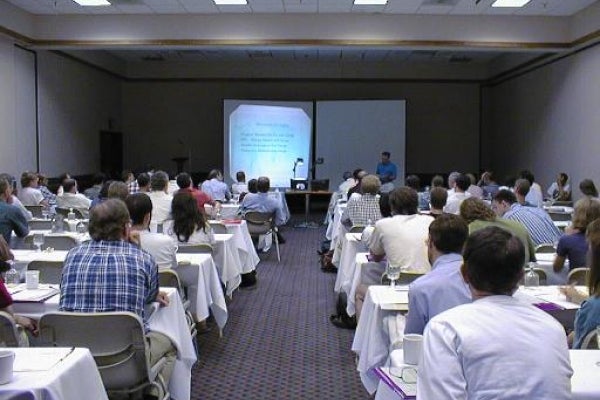
Caption
A picture from the 1997 CSM Workshop |
The CGD Admin team is searching for photos from past CESM Workshops for potential display at the forthcoming 30th Annual CESM Workshop (see below). If you have any photos, please submit them to this Google form. Any submission is greatly appreciated.
CESM Winter Working Group Video Recordings Available
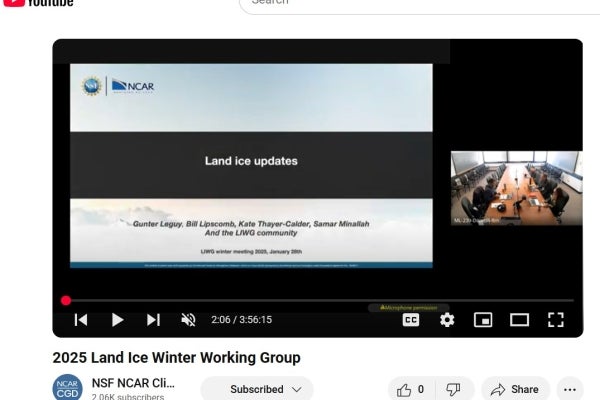
|
The recordings of the CESM Winter Working Group Meetings, which took place at the Mesa Lab from Jan. 27 to Mar. 5, 2025, are now available. The agenda for each working group meeting contains the recordings. The YouTube playlist can also be found here.
Research Highlights from Our Community
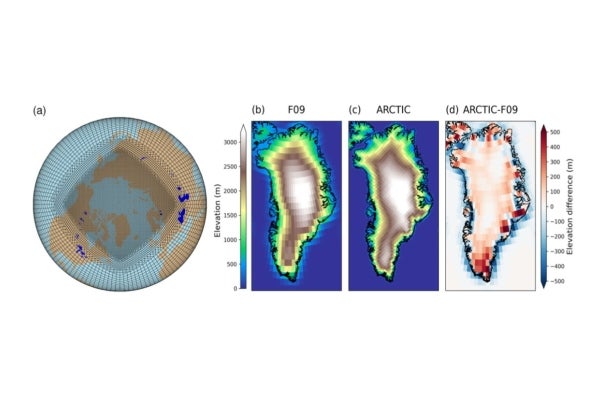
Caption
Impact of grids and dynamical cores in CESM2.2 on the surface mass balance of the Greenland Ice Sheet. |
Agricultural fertilization significantly enhances amplitude of land-atmosphere CO2 exchange
Danica L. Lombardozzi, William R. Wieder, Gretchen Keppel-Aleks, Jiameng Lai, Zhenqi Luo, Ying Sun, Isla R. Simpson, David M. Lawrence, Gordon B. Bonan, Xin Lin, Charles D. Koven, Pierre Friedlingstein & Keith Lindsay
Observations show an increase in the seasonal cycle amplitude of CO2 in northern latitudes over the past half century. Although multiple drivers contribute, observations and inversion models cannot quantitatively account for the factors contributing to the increased CO2 amplitude and older versions of Earth System Models (ESMs) do not simulate it. Here we show that several current generation ESMs are closer to the observed CO2 amplitude and highlight that in the Community Earth System Model (CESM) agricultural nitrogen (N) fertilization increases CO2 amplitude by 1-3 ppm throughout the Northern Hemisphere and up to 9 ppm in agricultural hotspots. While agricultural N fertilization is the largest contributor to the enhanced amplitude (45%) in Northern Hemisphere land-atmosphere carbon fluxes in CESM, higher CO2 concentrations and warmer temperatures also contribute, though to a lesser extent (40% and 18% respectively). Our results emphasize the fundamental role of agricultural management in Northern Hemisphere carbon cycle feedbacks and illustrate that agricultural N fertilization should be considered in future carbon cycle simulations.
The Role of Leaf Area Changes Within Plant CO2 Physiological Impacts on the Global Hydrological Cycle
Alana S. Cordak, Gabriel J. Kooperman, Claire M. Zarakas, Abigail L. S. Swann, Charles D. Koven
Rising atmospheric CO2 concentrations enhance greenhouse warming and drive changes to plant physiology, leading to innumerable climate impacts. This study explores the impacts of plant responses on hydrological cycling at 2x preindustrial CO2 concentrations by analyzing simulations that isolate plant physiological effects using the Community Earth System Model versions 1 and 2. We find that leaf area growth increases canopy evaporation, which offsets transpiration declines, and dampens changes in global mean evapotranspiration, precipitation, and runoff in a CESM2 experiment with dynamic leaf area. These leaf area impacts are also evident in the differences between CESM1 and CESM2, with CESM2 better capturing observed leaf area magnitudes but potentially overestimating leaf area-CO2 sensitivity, highlighting the importance of plant CO2 physiology on hydrological cycle changes and the need to improve its representation in climate models.
Improved Understanding of Multicentury Greenland Ice Sheet Response to Strong Warming in the Coupled CESM2-CISM2 With Regional Grid Refinement
Ziqi Yin, Adam R. Herrington, Rajashree Tri Datta, Aneesh C. Subramanian, Jan T. M. Lenaerts, Andrew Gettelman
The simulation of ice sheet-climate interactions, such as surface mass balance fluxes, is sensitive to model grid resolution. Here we simulate the multi-century evolution of the Greenland Ice Sheet (GrIS) and its interaction with the climate using the Community Earth System Model version 2.2 (CESM2.2) including an interactive GrIS component (the Community Ice Sheet Model v2.1 [CISM2.1]) under an idealized warming scenario (atmospheric CO2 increases by 1% yr −1 until quadrupling the pre-industrial level and then is held fixed). A variable-resolution (VR) grid with 1/4°regional refinement over the broader Arctic and 1°resolution elsewhere is applied to the atmosphere and land components, and the results are compared with conventional 1° lat-lon grid simulations to investigate the impact of grid refinement. Compared with the 1° runs, the VR run features a slower rate of surface melt, especially over the western and northern GrIS, where the ice surface slopes gently toward the periphery. This difference pattern originates primarily from higher snow albedo and, thus, weaker albedo feedback in the VR run. The VR grid better captures the CISM ice sheet topography by reducing elevation discrepancies between CAM and CISM and is, therefore, less reliant on the downscaling algorithm, which is known to underestimate albedo gradients. The sea level rise contribution from the GrIS in the VR run is 53 mm by year 150 and 831 mm by year 350, approximately 40% and 20% less than that of the 1° runs, respectively.
Quick Links
CGD YouTube Channel
CGD Instagram
CGD LinkedIn
CGD Bluesky
CESM User Support Forum
CVCWG Simulations
Simpler Models Information
Thanks for reading this CESM Newsletter! Expect to see the next one in the Summer of 2025. Please send potential Newsletter items to Elizabeth Faircloth.
